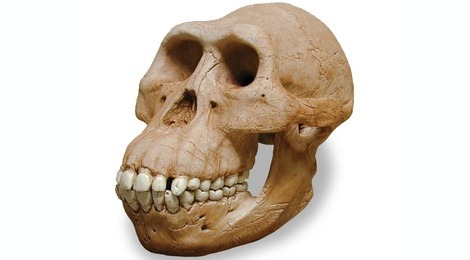The lantern jaw and the brow ridge aren’t accidentally related to testosterone production. We know that during development, testosterone levels during critical phases will determine certain male-dominated bone structures. Recently, a new hypothesis explains why the human face evolved the way it did.
On the Face of It
The researchers examined skulls of human ancestors, the australopiths, and the BBC has a good summary of the paper: http://www.bbc.com/news/science-environment-27720617
The idea is that an enlargement of the bones around the eye socket and the size of the jaw were not related to eating tough food and cracking nuts, but for protection against blunt force. The only blunt force that is likely to be aimed at the human face is the fist or blunt tool of another human. The enlargement of those bones is predominantly seen in the male, which points towards a cultural use of violence, which involves sexual selection.
Professor David Carrier of the University of Utah claims that a broken jaw would be a life-threatening injury in prehistoric times, and starvation would eliminate those who lost fights. He also argues that the in-fighting, as with chimpanzees and other primates, may be part of sexual selection, so the males who won those fist-fights would have more opportunities for mating and passing on their genes.
You don’t have facial buttressing. Evolution is not a straight-line, and as we became a more peaceful species, we lost the skull shape for taking punches to the head. Modern humans go to the hospital for fractured and dislocated jaws from fist fights, as well as broken noses and concussions.
By the way, these are the same researchers as we mentioned in a previous article about the evolution of the human fist.
The Punching Advantage
In my previous article Humans Evolved to Fight, I referenced a previous study by Carrier in which he argued that humans are the only great apes to be able to form a tight fist, and that was an advantage over other individuals who used their hands in combat by delivering hard slaps.
There is just as much controversy over both of these hypotheses. In the case of the fist, there is not much evidence that the punch is superior to the palm-strike, and modern boxers and other martial artists need to be educated on how to form a fist correctly (fold fingers into palm, wrap thumb over index and middle finger) or else risk injuring the hand. It is not instinctual, as would be expected if it evolved for that specialization.
Modern Pugilism
Whether you’re convinced by this research or not, it’s important to remember two things about fist-fights:
- Punching a skull may break your hand or wrist
- Taking a punch is really bad for your face and brain
If you’re not sure about those truths, remember that one of the best boxers of all time, Mike Tyson, broke his hand in a street fight when he wasn’t wearing boxing gloves, and they call it the “boxer’s fracture”. And with regard to concussions and brain damage, consider that “dementia pugilistica” is the name for long term and permanent cognitive impairment from repeated blows to the head (read my articles about concussions).
So, if you can’t practice avoidance of a dangerous situation, then practice these two adjustment to your priorities while at striking range:
- Save your clenched fist for body-shots, especially a cross to the mark; palm-strike the face instead of punching.
- Evasion should be your primary defence
Pugilists in the Victorian era faced this reality every match, and our Bartitsu class examines fisticuffs from this practical standpoint.
Announcements
Remember that there is no Fight Like Sherlock Holmes introductory course in July, so if you’d like to join the Academie Duello Bartitsu training, you can sign up for one of the August sessions, or contact me by email: david@academieduello.com to arrange a private lesson.
There will be a test at the end of July for candidates to earn their Blue Sash. If you’re interested in testing (having joined us no later than April, 2014), speak to instructor David McCormick in class when he returns from the FDC National workshop 14-July.
